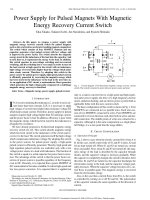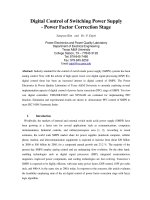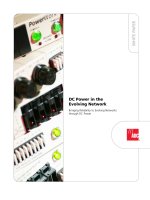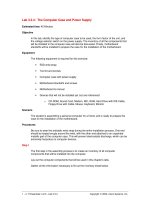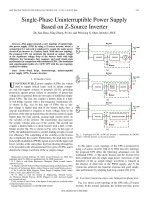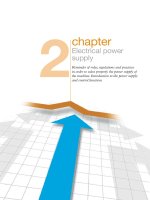LINEAR DC POWER SUPPLY
Bạn đang xem bản rút gọn của tài liệu. Xem và tải ngay bản đầy đủ của tài liệu tại đây (3.39 MB, 56 trang )
DC POWER SUPPLY
LINEAR DC POWER SUPPLY
Importance of DC power supply:
Most electric equipment requires DC voltage.
Dry cells unable to accommodate the needs of electrical
equipments.
Power supplied to the house in AC but electrical equipment
needs DC voltage.
DC POWER SUPPLY
LINEAR DC POWER SUPPLY
Block Diagram :
DC POWER SUPPLY
LINEAR DC POWER SUPPLY
Function Of Each Block :
Transformer - steps down high voltage AC mains to low
voltage AC.
Rectifier - converts AC to DC, but the DC output is pulsating (varying)
DC wave.
Filter - smoothes the DC from varying greatly to a small ripple.
Regulator - eliminates ripple by setting DC output to a fixed voltage.
Voltage divider – distributes DC output voltage to load.
EXAMPLE OF LINEAR DC POWER SUPPLY
DC POWER SUPPLY
TRANSFORMER
Circuit symbols
Transformer with two windings and iron core.
Step-down or step-up transformer. The symbol shows which winding has more turn but not usually the exact
ratio.
DC POWER SUPPLY
TRANSFORMER
Transformers convert AC electricity from one voltage to another with little loss of power.
Transformers work only with AC and this is one of the reasons why mains (wall socket)
electricity is AC.
Step-up transformers increase voltage, step-down transformers reduce voltage.
Most power supplies use a step-down transformer to reduce the dangerously high mains
voltage (240V in Malaysia) to a safer low voltage.
DC POWER SUPPLY
TRANSFORMER
•
The input coil is called the primary and the output coil is called the secondary.
•
There is no electrical connection between the two coils, instead they are linked by an
alternating magnetic field created in the soft-iron core of the transformer.
•
The two lines in the middle of the circuit symbol represent the core.
DC POWER SUPPLY
TRANSFORMER
Ideal Power Equation
Vp ; Primary (input) Voltage
Np ; Number of turns on primary coil
Ip ; Primary (input) Current
Vs ; Secondary (output) Voltage
Ns ; Number of turns on secondary coil
Is ;
Secondary (output) current
A step-down transformer has a large number of turns on its primary (input) coil which is
connected to the high voltage mains supply.
A small number of turns on its secondary (output) coil to give a low output voltage.
If the secondary coil is attached to a load that allows current to flow, electrical power is
transmitted from the primary circuit to the secondary circuit.
Ideally, the transformer is perfectly efficient; all the incoming energy is transformed from the
primary circuit to the magnetic field and into the secondary circuit.
If this condition is met, the incoming electric power must equal the outgoing power:
Ip = primary (input) current
Is = secondary (output) current
Note that as voltage is stepped down, current is stepped up. If the voltage is increased, then
the current is decreased by the same factor.
An ideal transformer would have no energy losses, and would be 100% efficient.
In practical, transformers waste very little power so the power out is (almost) equal to the
power in. Transformers energy is dissipated in the windings, core, and surrounding
structures. Larger transformers are generally more efficient, and those rated for electricity
distribution usually perform better than 98%.
DC POWER SUPPLY
RECTIFIER
Conversion of alternating current (or voltage) into direct current (or
voltage) is called rectification.
A diode is well-suited for this job because it only conducts when
forward-biased.
DC POWER SUPPLY
RECTIFIER
Types Of Rectifiers :
Half-wave rectifier
Full-wave rectifier
Bridge rectifier
DC POWER SUPPLY
HALF-WAVE RECTIFIER
An a.c voltage is applied to a single diode connected in series with a load resistor,
RL.
A single diode can be used as a rectifier but this produces half-wave varying DC which
has gaps when the AC is negative.
It only uses the positive (+) parts of the AC wave to produce half-wave varying DC.
Schematic diagram :
DC POWER SUPPLY
CIRCUIT OPERATION :
The AC voltage polarity across the secondary winding changes after every half cycle.
During the positive half-cycles of the input AC voltage:
a) The diode, D is forward biased and conducts current.
b) The input voltage during the positive half-cycles is directly applied to the load,
R.
c) The waveforms of the output voltage during t0 to t1 are of the same shape as
that of the input AC voltage.
During the negative half cycles of the input AC voltage:
a) The diode, D is reverse biased and does not conduct current.
b) The current and voltage across the load, R remains zero.
c) For the negative half cycles t1 to t2, no power is delivered to the load, R.
INPUT AND OUTPUT VOLTAGE
@ VP(sec) – 0.7V
@
DC POWER SUPPLY
FULL-WAVE RECTIFIER
The full-wave rectifier circuit using two diodes and a centre-tapped transformer, which
usually taken as the ground or zero voltage reference point.
It is called a full-wave rectifier because it uses the entire AC wave (both positive and
negative sections).
There are two main types of full wave rectifiers:
a) Center-tapped full-wave rectifier
b) Bridge rectifier
a) Center-tapped full-wave rectifier :
Center-tapped full-wave rectifier circuit :
Two diodes connected to the secondary of a center-tapped transformer can form a full-wave
rectifier that allows both half-cycles of the AC waveform to contribute to the DC making it
smoother than a half-wave rectifier
Grounded center tapped results in ½ secondary voltage reaching the load.
The purpose of centre-tapped transformer is to get two a.c output with the same value but in
inverse phase.
INPUT & OUTPUT VOLTAGE
OPERATION :
a). During positive half cycle, D1 is forward biased & D2 is reverse biased.
b). During positive half cycle, D1 is forward biased & D2 is reverse biased.
* At any point in time, only one of the diodes is forward biased.
* This allows for continuous conduction through load.
b) Bridge rectifier
Bridge rectifier circuit:
- A bridge rectifier can be made using four individual diodes.
INPUT & OUTPUT VOLTAGE
@
OPERATION :
a). During positive half-cycle, D1 & D2 are forward biased and conduct current. D3 & D4 are reverse-biased.
b). During negative half-cycle, D3 & D4 are forward biased and conduct current. D1 & D2 are reverse-biased.

